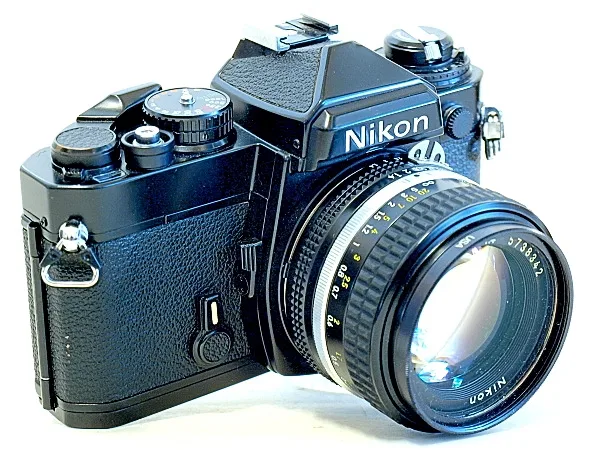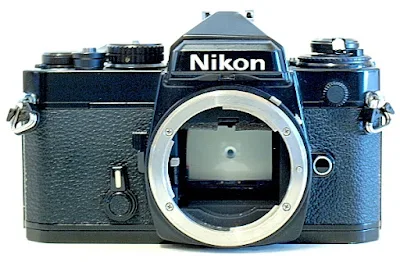The Vintage Enthusiast: An advanced semi-professional and user-friendly manual focus autoexposure 35mm SLR film camera from Nikon.
Nikon introduced the compact and moderately priced F-series 35mm film SLRs in 1977 with the launch of the Nikon FM. Built on a compact, yet tough copper-aluminum alloy chassis, the FM started what was to be a robust and long-lived series of small, and compact semi-professional Nikon SLRs, namely the FM, FM2, FE, FE2, FA, and FM3A.
While the FM was entirely a mechanical contraption, the Nikon FE, introduced in 1978, was built with similar mechanical components (springs, gears, levers) as the FM, with added electronic control components, is electromechanical.
The Nikon FE offers both manual exposure and the electronic shooting mode of the day, aperture-priority autoexposure.
Just like the FM, the FE turned out to be a good seller as well. The camera is robust and reliable, and it is now acknowledged as one of the finer SLRs of its generation. The FE stayed on the production line until 1983 when it was replaced by the FE2.
Nikon FE Review
Hashem reviews his daily 35mm shooter, the Nikon FE.
Design and Build
The Nikon FE is a fun and very easy-to-use advanced enthusiast-level aperture-priority autoexposure 35mm film SLR camera. The camera is equipped with an electronically-controlled, vertical-travel focal-plane shutter with speeds from 8 seconds to 1/1000 second, a mechanical backup speed of 1/90 second, and B(ulb), for long exposure.The camera also provides for full manual shooting mode via matching needle viewfinder readout, +2EV exposure compensation in 1/2 stops, film ISO range from 12 to 3200, and a self-timer lever that doubles as an exposure lock lever. DoF (depth of field) preview is provided via a stop-down lever which also acts as stop-down metering for use with non-AI lenses.
The FE is capable of doing multiple exposures and comes with a battery check light and a film memo holder on the film door. Film advance is still crank-and-wind vintage, metering is activated when the film forward crank is pulled out from its rest position.
Basic Camera Features
The FE is available both in black and chrome. As normal on auction sites, the black paint version normally goes for higher bids. Nevertheless, both of these compact bodies (weighing 590 grams) are very robust, feel solid in your hands, and will do a lot to help build up your confidence and skill as a film photographer. With proper care and handling these cameras should last forever.The main controls for the camera are, as usual, on the top plate. To the right of the pentaprism, which houses the hot shoe, are the shutter selector dial, shutter release button, film advance crank, film counter window, and a small lever for multiple exposure control. Setting the shutter speed to 'AUTO' requires you to press a small knob on top of the dial before rotating the dial.
On the left of the top plate is the find rewind crank, which is integrated with the film ISO selection and exposure compensation dial. Press the knob beside the dial to rotate the film ISO setting, do the pull-up, and turn the outermost ring of the combination dial to adjust doe exposure compensation.
The front plate of the FE's body carries the mandatory lens release lock to the right of the lens mount housing, and the sync socket towards the top of the panel. On the left is the self-timer/exposure lock lever, the stop-down lever is located on the vertical of the lens mount housing just aside from the self-timer.
Aside from the film memo holder on the film back, the only other facility available on the camera back is the battery check lever and light, which are located towards the left back of the top panel. The bottom plate has the battery chamber cover, rewind release button, and the coupling and electrical contacts for the motor drive.
Viewfinder Readout
The TTL (through the lens) exposure value calculations are indicated by a pair of pointers, an 'exposure value' pointer which is calibrated against a vertical shutter speed bar located on the left of the screen, and a flat 'Green' pointer which reflects the shutter speed selection itself.
A small ADR (Aperture Direct Readout) window is located in the middle of the top frame of the screen, which shows the aperture setting of the lens.
Aperture-Priority Auto exposure
Once you have framed and focused your image, use your creativity to set the lens aperture as you see fit - wide for a shallower depth of field, the opposite for a deeper one, or anywhere in between - and the FE will set the corresponding the shutter-speed for the best exposure automatically.
Manual Exposure Control
Manual exposure control in the FE is the match needle experience, where you adjust the exposure meter pointer, by varying your lens aperture opening, to align with the 'Green' shutter speed needle. Depending on your priority, you can also preset your lens aperture to a certain opening width, and then use the shutter speed dial to do the needle match to get the optimum exposure reading.Adjusting the exposure pointer needle to a point higher than the shutter speed mark means that you are going for over-exposure (high-key) while doing the opposite means that you are going for an under-exposed (low-key) image.
Depth-of-Field Preview/Stop-down Metering
You will still do the match needle experience here, but you do it with the Depth-of-Field preview lever pressed while you adjust either the aperture ring setting or shutter speed setting.
Multiple Exposure
I tried to be deft about this, have never been successful, and have always ended this as a two-handed operation. All you need to do to get the shutter cocked for the next shot, without winding the film frame forward, thus enabling you to do multiple exposure shots, is to pull the small tab located under the film advance crank back while cranking the lever itself. Simple!Battery
The Nikon FE uses a pair of SR or LR44 batteries to power the metering system of the camera. A pair of batteries can last you a couple of years even with regular use. The cost here is almost negligible. The batteries, however, will tend to corrode if left in the camera unattended for extended durations. Something to watch out for!Preference over the FE2
While the Nikon FE may be overlooked by enthusiasts who have a preference for the FE2, which on most occasions is influenced by the FE2's faster shutter speeds (1/2000 and 1/4000 seconds, and flash sync speed at 1/250 seconds), one thing the FE2 cannot be used with non-Ai lenses.The FE has an automatic mirror lockup when used with the self-timer, but not otherwise, and there was a mention somewhere that the FE is ideal for night photography, with its extended metered timing capability.
Using The Camera
As most Nikons do, the FE is a smooth operator, and the shutter speed dial is easy to handle, with safety features like the center button on the shutter speed dial which has to be pressed before you can exit the 'AUTO' mode. The film advance lever is amazingly smooth and fast with its single-stroke action. On a good unit, metering on the Nikon FE is infallible.While the Nikon FM, with all its mechanical robustness, is one camera that may hardly fail, the Nikon FE, with its electrical circuitry does have the potential of connection corrosion, frayed wiring, or other electrical ailments that may bring it to its demise. This is something you should be wary of when looking for a purchase. Other than that the camera is simply a joy to use and keep.























No comments:
Post a Comment